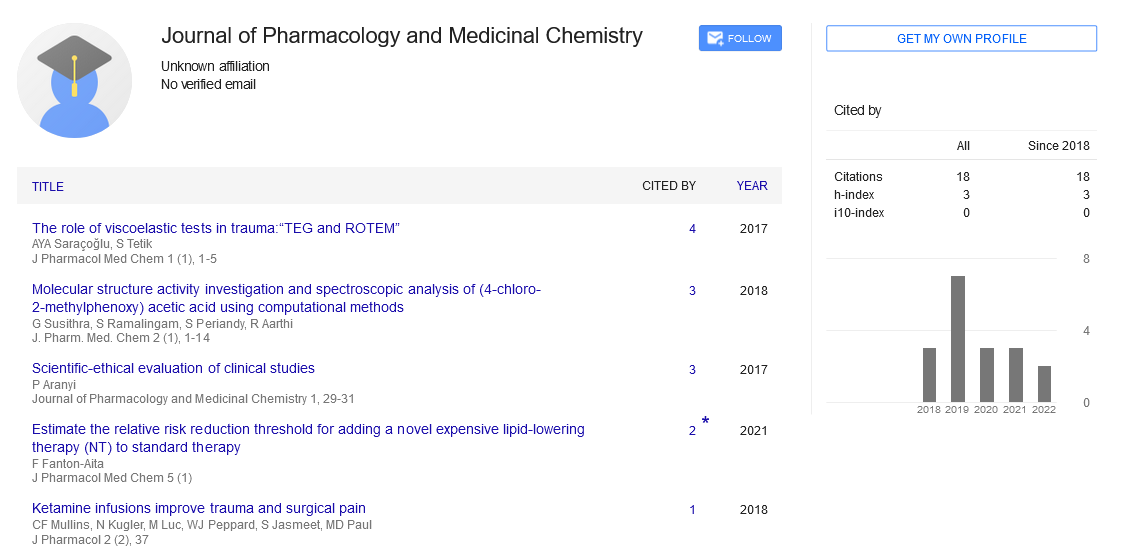Synthesis of natural compounds in sufficient quantities
Received: 01-Nov-2021 Accepted Date: Nov 16, 2021; Published: 23-Nov-2021
This open-access article is distributed under the terms of the Creative Commons Attribution Non-Commercial License (CC BY-NC) (http://creativecommons.org/licenses/by-nc/4.0/), which permits reuse, distribution and reproduction of the article, provided that the original work is properly cited and the reuse is restricted to noncommercial purposes. For commercial reuse, contact reprints@pulsus.com
Editorial Note
ynthesis of natural compounds in sufficient quantities. Synthesis of analogs to optimize biological activity of lead compounds, structure activity relationships and lead optimization. Medicinal chemistry is discipline at the intersection of chemistry, especially synthetic organic chemistry, and pharmacology and various other biological specialties, where they are involved with design, chemical synthesis and development for market of pharmaceutical agents, or bio-active molecules (drugs) Compounds used as medicines are most often organic compounds, which are often divided into the broad classes of small organic molecules atorvastatin, fluticasone, clopidogrel and biologics (infliximab, erythropoietin, insulin glargine), the latter of which are most often medicinal preparations of proteins (natural and recombinant antibodies, hormones etc.). Inorganic and organometallic compounds are also useful as drugs (lithium and platinum-based agents such as lithium carbonate and cisplatin as well as gallium). In particular, medicinal chemistry in its most common practice focusing on small organic molecules encompasses synthetic organic chemistry and aspects of natural products and computational chemistry in close combination with chemical biology, enzymology and structural biology, together aiming at the discovery and development of new therapeutic agents. Practically speaking, it involves chemical aspects of identification, and then systematic, thorough synthetic alteration of new chemical entities to make them suitable for therapeutic use. It includes synthetic and computational aspects of the study of existing drugs and agents in development in relation to their bioactivities biological activities and properties. Understanding their Structure Activity Relationships (SAR). Pharmaceutical chemistry is focused on quality aspects of medicines and aims to assure fitness for purpose of medicinal products. At the biological interface, medicinal chemistry combines to form a set of highly interdisciplinary sciences, setting its organic, physical, and computational emphases alongside biological areas such as biochemistry, molecular biology, pharmacognosy and pharmacology, toxicology and veterinary and human medicine; these, with project management, statistics, and pharmaceutical business practices, systematically oversee altering identified chemical agents such that after pharmaceutical formulation, they are safe and efficacious, and therefore disease.
Process Chemistry and Development
The final synthetic chemistry stages involve the production of a lead the latter brings in the specialization of formulation science (with its components of physical and polymer chemistry and materials science). The synthetic chemistry specialization in medicinal chemistry aimed at adaptation and optimization of the synthetic route for industrial scale syntheses of hundreds of kilograms or more is termed process synthesis, and involves thorough knowledge of acceptable syntheticpractice in the context of large scale reactions (reaction thermodynamics, economics, safety, etc). Critical at this stage is the transition to more stringent GMP requirements for material sourcing, handling, and chemistry.The synthetic methodology employed in medicinal chemistry is subject to constraints that do not apply to traditional organic synthesis. Owing to the prospect of scaling the preparation, safety is of paramount importance. The potential toxicity of reagents affects methodology. The structures of pharmaceuticals are assessed in many ways, in part as a means to predict efficacy, stability, and accessibility. Lipinski's rule of five focus on the number of hydrogen bond donors and acceptors, number of rotatable bonds, surface area, and lipophilicity. Other parameters by which medicinal chemists assess or classify their compounds are: synthetic complexity, chirality, flatness, and aromatic ring count. Structural analysis of lead compounds is often performed through computational methods prior to actual synthesis of the ligand. This is done for a number of reasons, including but not limited to: time and financial considerations (expenditure). Once the ligand of interest has been synthesized in the laboratory, analysis is then performed by traditional methods. Combining the considerable organic synthesis expertise with other complementary and synergistic aspects of modern medicinal chemical research, our department continues to be a leader among its peers worldwide. Building on the rich tradition, organic synthesis intensive and medicinal chemical target-related research activities of the present day faculty include, total synthesis of natural products, asymmetric synthesis, development of new methodologies, studying reaction mechanism, Structure-Activity Relationship (SAR) investigations, creation of new structural scaffolds and synthesis of biomimetic non-natural.





